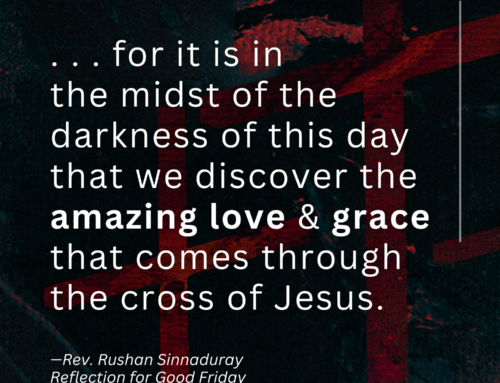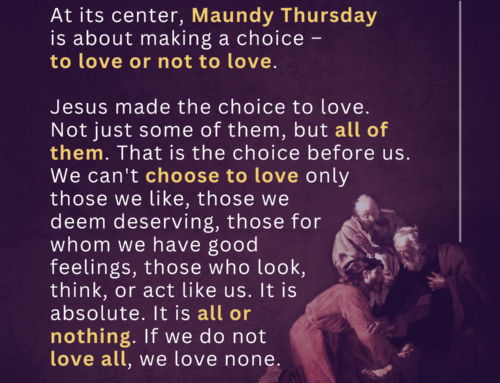“SACRED SCARS”
by Rebecca Woodland, CUC member
Wounds are not pretty. Physical wounds are often ugly, smelly, frightening, and repulsive. If neglected, the wound becomes infected, and the resulting infection may spread and create a far worse problem than the original wound itself. In extreme cases, it can result in amputation or even death. Wounds cannot be erased or deleted. They must first be acknowledged, not hidden or ignored.
Some wounds may not be easily seen or accessed. This is especially true of wounds to the soul. Trauma creates psychological and spiritual wounds, as well as taking a toll on a person’s physical well-being. As Bessel van der Kolk explains in his best-selling book The Body Keeps the Score, “The body bears the marks of trauma in ways that escape cognitive knowledge.” Trauma encompasses not only the event, but the events leading up to and surrounding the event, and the aftermath of the event. The past does not stay in the past. It invades the present, returning at unexpected times. Theology historically (and currently, in many cases) has tried to erase these wounds, to pretend they never existed rather than attend to the wounds. For healing to take place, pain needs to be confronted for what it really is.
The church’s tendency to rush past the trauma, proclaiming the “good news” before its time, is like celebrating Easter/Resurrection without first acknowledging and grieving the Crucifixion/ Death, and experiencing/witnessing the profound darkness in the unknown chasm between death and resurrection. When the redemptive narrative of Cross and Resurrection is read and taught in linear fashion, as a series of events on a timeline, it tends to skip the process that must be undertaken ~ the grieving, that middle Holy Saturday, finding God’s presence in the abyss, when we do not yet know the outcome.
This push to move beyond the event is a dangerous move that threatens to rub out the realities of traumatic suffering. This often creates more and deeper wounds, which may manifest belatedly and unpredictably in the form of fragmentary visions, flashbacks and symptoms that show up randomly and out of context. This also increases the likelihood that the suffering will be ongoing or repeated, rather than acknowledged, treated, and healed.
The typical American considers a broken or cracked thing to be worthless, unsalvageable, something to neglect or discard because it is no longer considered useful or beautiful. In Japan, instead of tossing broken pottery in the trash, some craftsmen practice the 500-year-old art of kintsugi, or “golden joinery,” which is a method of restoring a broken piece with a lacquer that is mixed with gold, silver, or platinum. Kintsugi gives new life, healing, or rebirth to damaged pottery by celebrating, not hiding, their flaws and history. The flaw is seen as a unique piece of the object’s history, which adds to its beauty. Breakage and mending are honest parts of a past which should not be hidden or disguised.
God is the Potter, and we are clay in the Potter’s hands. As Isaiah declares: “O LORD, you are our Father. We are the clay, and you our potter; and all of us are the work of your hand.” God
shapes and molds us into something unique, beautiful, and useful, as we submit to God. We endure fiery trials in the kiln of life. These trials strengthen us and prepare us for greater usefulness.
But what happens when the pot breaks? We have all been broken. What do we do with the broken pieces? Hide them? Throw them in the trash? Pretend nothing happened?
Pick up the broken pieces. All of them.
Our wounds and healing are a part of our history; a part of who each of us is. When something has suffered damage and has a history, it becomes more beautiful. The kintsugi method conveys a philosophy not of replacement, but of awe, respect, and restoration. The gold-filled cracks of a once-broken item are a testament to its history. Consider this when you feel broken.
Kintsugi symbolizes reconciliation with the traumas and accidents of time, does not attempt to hide or disguise the damage, and renders the fault lines beautiful and strong. God is our “kintsugi artist”. Instead of trying to hide or disguise our brokenness, give the broken pieces of our lives to God. Broken dreams, broken relationships, broken health, broken promises, broken finances, broken hearts. We have been sinned against, and we have sinned against others. God redeems the broken pieces of our lives and creates something even more beautiful and valuable than the original unbroken vessel. God sees through our brokenness and recognizes the treasure in our scars. The path to wholeness begins with facing and admitting our brokenness. Give the broken pieces to God. All of them. God lovingly heals our broken places and makes us stronger, restoring us to usefulness and making us whole again.
The care and love God expends on shattered pieces encourages us to respect and honor what is damaged and scarred, vulnerable and imperfect, starting with ourselves and those around us. Sadly, the typical Christian narrative tends to do the exact opposite. It tries to erase the wounds rather than attend to them, hiding the scars instead of respecting them as a sign of healing.
God declares, “My grace is sufficient for you, for My power is made perfect in your weakness.” God comes to us in the midst of our weakness, our shattered-ness, our helplessness, our frayed sense of agency. When we confront and admit our own weakness and brokenness, and give all the broken pieces to God, we allow the kintsugi artist (God) to repair our damaged selves, making us stronger, more beautiful, and useful. “This is truly what grace is, in its most radical form: …the incredible insistence on love amid fragmented, unraveled human lives.”
In the words of the Apostle Paul, “We have this treasure in earthen vessels to show that this all-surpassing power is from God and not from us.”1 Everything human is an earthen vessel for God’s treasure. Nothing human can bury God’s treasure.
God is both the Potter and the kintsugi artist. We are the clay pots, the “earthen vessels.” As Potter, God holds and molds us. When the pot cracks or breaks, the Potter embraces the brokenness ~ all of it ~ and lovingly begins the kintsugi process of healing, restoring, strengthening, and creating something even more beautiful out of the broken pieces, as we submit to him. This is not a one-time fix, but a lifetime journey of offering our brokenness to God and submitting to his kintsugi reconstruction process.






